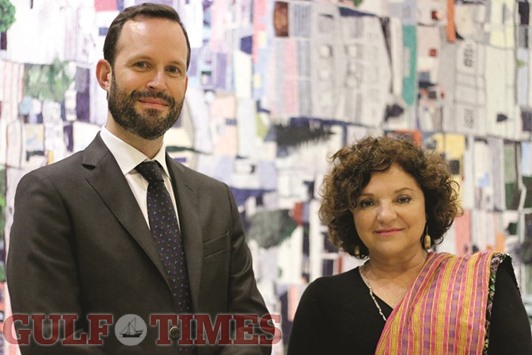Therefore, Mexican artist Paloma Torres’s work is focused on creating awareness about the importance of public spaces in cities. Through her sculptures, many of which have been put in different big cities of the world, she advocates cutting down on extra in the ways of construction and achieving maximum space.

In this textile piece, Paloma shows aerial view of Mexico City, emphasising the shrinking space.
“With my ceramics sculptures, I construct the kind of buildings that nobody is going to live in,” jokes Paloma, talking to Community at the opening of her first exhibition at Katara Cultural Village here recently.
Coming from Mexico City, one of the most densely populated cities in the world, Paloma believes space is for social development.
“If you do not have space you start having a very narrow point of view,” she points to one of her installations, a textile tapestry hanging on the wall, at the exhibition. The woven piece of drapery gives an aerial view of Mexico City, with no space in between construction visible to the viewer.

The artist says having enough public space is vital to social development.
“I took my pictures of the Mexico City from air and once I had them all in different angles I wove them into the tapestry. Our Ambassador to Qatar thought
that it would be great to bring it here to Katara as the culture in textile is very big here,” says Paloma.
Ambassador of Mexico in Qatar, Francisco Niembro says he is happy at the opening of first exhibition of a renowned and established Mexican artist in Doha since the opening of Mexico embassy here in Doha in the year 2014.
“This is a very innovative technique with originality, showing Mexico City which you know is one of the biggest cities in the world. We are happy to have it (exhibition) here,” Niembro tells Community.

Paloma’s work is focused on creating awareness about the importance of public spaces in cities.
He says he likes every form of art and particularly likes sculptures as they are more complex and 3-dimensional. Ambassador Niembro says he did not want to commit anything but he would try his best to continue bringing more Mexican artists to Doha.
“I am happy to bring this marvellous exhibition here and will try to keep this trend going. Here I would especially want to thank Katara Cultural Village Foundation because without them it would not have been possible,” says the Mexican ambassador.
Paloma Torres was coming from an exhibition in London in Canary Wharf where she worked on a sculpture — “Constructing the rain” — to be displayed in London. It is a piece designed to show the intimate relationship between the city and nature.
It is a piece in bronze with a cloud on the scaffolding fixed in a bench. The sculpture is both playful and utilitarian. And that is how Paloma wants her sculptures to be.
“I wanted do something that can be utilitarian. I wanted people to have space to sit down and be part of the sculpture,” says Paloma.
Besides a selection of sculptures made from textile, she has a good collection of piece of art similar to draperies and wall-hangings. The most striking, however, is the giant aerial view of her native city.
“This is a textile. It is weaved. And these are photographs of Mexico City that I took from air in a helicopter. You can see that we live in a very crowded city. Of course there must be a boundary of the city but you can see here how fast we are losing space in this big city,” Paloma says, explaining her artwork.
She refers to the display of her piece here in Doha as “weaving of the two cultures.”
“In a way my work has drifted more towards this kind of technique but basically I am a sculptor. I make sculptures in ceramics and some of them are as tall as 7 metres. I have some sculptures in ceramics here in Georgetown University Qatar,” the artist reveals.
She says it took her seven months to complete this piece of art as she could only do 20cm in a week. It is made on a loom similar to the carpet weaver’s. However, her other installations were made with the technique felting where you work with natural colours and you insert them with very fine needles.
Felt is a textile that is produced by matting, condensing and pressing fibres together. Felt can be made of natural fibres such as wool or synthetic fibres such as acrylic. While some types of felt are very soft, others are tough enough to form construction materials.
She took the pictures of Mexico City from air in the helicopter of an owner of a Museum and then also took pictures of excavation for subway in the city. Paloma says she wanted to see “the belly of her city. How come 22 million people live in a city and do not destroy it?”
“I love my city. I come from a family of architects. Since my childhood I have been listening to expressions like ‘feel the space.’ My father was an architect in Mexico City and the city has been like a garden to me,” recalls Paloma. She says she has grown up watching it.

Another one of the artist’s expression.
“I think that the spirit of a society has a lot to do with the quality of cities they have and by quality I mean having a dignified space for all the inhabitants to work and live,” says Paloma.
“For me, the most important part of my work is the process because process is the way you are connected with a piece of art,” says the artist.
And the art, she adds, is part of our lives because culture is…what is how we live our daily life; it is not something alien. Paloma believes if we (human beings) can learn this, we can eliminate all the violence from the world and in people’s lives.
She opines that the governments and the people in power around the world should think more in providing quality life to the people. Human condition is the same all everywhere in the world and all the destruction is happening because “we don’t have faith in anything.”
“We have frustrated societies and we do not give them tools to express themselves, not in a violent but a creative way,” says the artist.
She stressed the need for teaching people the importance of art and culture as it would give birth to more intelligent societies who are going to have a wider point of view about life. Her exhibition, ‘The Urban Weaving’ will remain on display in building 18 at Katara Cultural Village till the end of this month.



